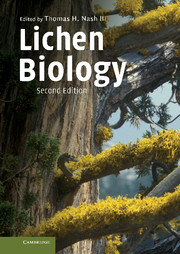Book contents
- Frontmatter
- Contents
- List of contributors
- Preface
- 1 Introduction
- 2 Photobionts
- 3 Mycobionts
- 4 Thallus morphology and anatomy
- 5 Morphogenesis
- 6 Sexual reproduction in lichen-forming ascomycetes
- 7 Biochemistry and secondary metabolites
- 8 Stress physiology and the symbiosis
- 9 Physiological ecology of carbon dioxide exchange
- 10 The carbon economy of lichens
- 11 Nitrogen, its metabolism and potential contribution to ecosystems
- 12 Nutrients, elemental accumulation, and mineral cycling
- 13 Individuals and populations of lichens
- 14 Environmental role of lichens
- 15 Lichen sensitivity to air pollution
- 16 Lichen biogeography
- 17 Systematics of lichenized fungi
- Appendix: Culture methods for lichens and lichen symbionts
- References
- Taxon index
- Subject index
1 - Introduction
Published online by Cambridge University Press: 05 September 2012
- Frontmatter
- Contents
- List of contributors
- Preface
- 1 Introduction
- 2 Photobionts
- 3 Mycobionts
- 4 Thallus morphology and anatomy
- 5 Morphogenesis
- 6 Sexual reproduction in lichen-forming ascomycetes
- 7 Biochemistry and secondary metabolites
- 8 Stress physiology and the symbiosis
- 9 Physiological ecology of carbon dioxide exchange
- 10 The carbon economy of lichens
- 11 Nitrogen, its metabolism and potential contribution to ecosystems
- 12 Nutrients, elemental accumulation, and mineral cycling
- 13 Individuals and populations of lichens
- 14 Environmental role of lichens
- 15 Lichen sensitivity to air pollution
- 16 Lichen biogeography
- 17 Systematics of lichenized fungi
- Appendix: Culture methods for lichens and lichen symbionts
- References
- Taxon index
- Subject index
Summary
The symbiosis
Lichens are by definition symbiotic organisms, usually composed of a fungal partner, the mycobiont (Chapter 3), and one or more photosynthetic partners, the photobiont (Chapter 2), which is most often either a green alga or cyanobacterium. Although the dual nature of most lichens is now widely recognized, it is less commonly known that some lichens are symbioses involving three (tripartite lichens) or more partners. The potential relationships of mycobionts and photobionts may in fact be quite complex (Chapter 4), and a rigorous classification of many types of relationships was developed by Rambold and Triebel (1992). In general, lichens exist as discrete thalli and are implicitly treated as individuals in many studies (but see Chapter 13), even though they may be a symbiotic entity involving three kingdoms! From a genetic and evolutionary perspective, lichens can certainly not be regarded as individuals and this fact has major implications for many areas of investigation, such as developmental and reproductive studies (Chapter 5).
The nature of the lichen symbiosis is widely debated and deserves further investigation. Most general textbooks and many researchers refer to lichens as a classical case of mutualism, where all the partners gain benefits from the association. Alternatively, lichens are regarded as an example of controlled parasitism, because the fungus seems to obtain most of the benefits and the photobiont may grow more slowly in the lichenized state than when free-living (Ahmadjian 1993).
- Type
- Chapter
- Information
- Lichen Biology , pp. 1 - 8Publisher: Cambridge University PressPrint publication year: 2008
- 20
- Cited by

